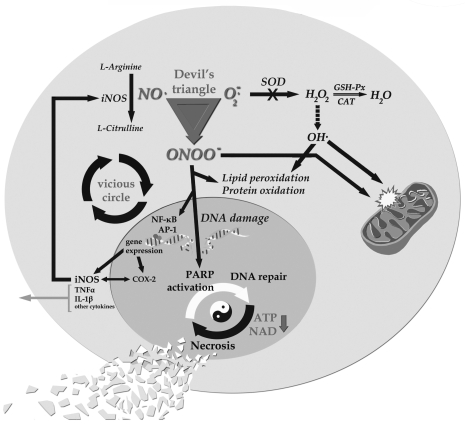Figure 2.
Consequences of the “devil’s triangle” (92). ONOO− exerts its harmful effects directly and indirectly. It causes activation of transcriptional factors leading to proinflammatory gene expression. As a result, nitrooxidative stress becomes an inflammatory process. Interactions between transcriptional factors and proinflammatory products induce a vicious circle. These cytokines spread the inflammatory message through the circulation. Unless excess O2•− and iNOS-derived NO production are terminated (for example, through normalizing of blood glucose level, cessation of smoking), this mechanism continues to create damage within cells (for example, endothelial dysfunction). Moreover, ONOO− directly damages all macromolecules including lipids, proteins, and DNA. It is well known that both oxygen and nitrogen-based reactants directly damage mitochondria. The majority of NAD+ consumed by PARP also slows the rate of glycolysis and mitochondrial respiration, and eventually leads to cellular dysfunction. Antioxidant vitamins have no effect on ONOO−-induced subsequent cellular damage. Melatonin, however, is a unique molecule which possesses beneficial effects in virtually all steps of the pathophysiologic process. Melatonin blocks proinflammatory cytokine production by reducing NF-κB and AP-1 translocation into the nucleus and directly inhibits iNOS and inflammatory enzyme COX-2. These features break the vicious circle and alleviate the inflammation. Melatonin preserves cellular energy by several means and has been shown to prevent all types of nitrooxidative damage at the mitochondrial level.

